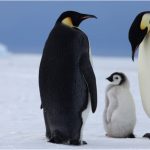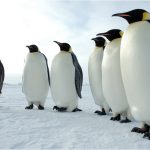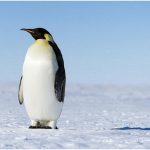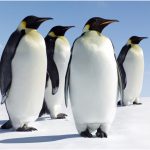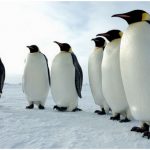The emperor penguin is considered the tallest and the heaviest among all living species of penguins. They spend their entire lives on the ice and surrounding waters in the Antarctica despite the harsh climatic conditions in the part of the planet.
Emperor Penguin Facts For Kids & Information :
- They stand at 1.15 m (45 inches) tall.
- Emperor penguin is the only animal to inhabit the open ice and extreme cold of the Antarctica during winters
- They can survive up to -60°C (-76°F) and extreme blizzards of 200km/h (124 mph).
- They attain speeds of 3.4 m/s (7.6 mph) navigating through the waters
- Emperor penguin dives deeper than any other bird at 565 m (1850 ft) deep. They can also stay in water for more than 20 minutes.
- It is the only species of penguins that breeds in the winters in the Antarctic; they traverse up to 120 km looking for favorable breeding colonies.
- Female penguin lays an egg which it leaves the male penguin to incubate while it gets back to the waters to feed
- Emperor penguin weighs up to 45 kg (99 lbs)
- The largest of the penguins and the fifth largest of all existing birds all across the world
Description Of The Bird :
- A fully grown emperor penguin stands up to 130m (51 inch) tall and can attain a maximum weight of 45 kg (which is 100lb) but this varies with the sex of the penguin with male penguin weighing slightly more than female. It is the largest of all the penguin species but ranks fifth heaviest of all the bird species that exist.
- The weight, however, varies with seasons as both sexes lose substantial amount of weight in incubating the eggs and raising their hatchlings. The male emperor penguin withstands the harsh and extreme colds of the Antarctica for two months protecting the egg from the weather conditions. It does not feed on anything during this entire time.
- Just like all other penguins, emperor penguin has a streamlined body effective for swimming and stiff and flat flipper wings. They exist in two popular colors, black and white in adults but there are traces of bright yellow around their necks and years. The chicks are silver grey in color.
Communication :
Unlike other birds, penguins do not have nests where they can easily locate their partners or chick; emperor penguin use the vocal calls in identifying their partners. The intricate vocal calls are useful for recognizing a parent, offspring, or mate, particularly in a colony.
Adaptation To Cold, Pressure and Low Oxygen :
Emperor penguins are adapted to survive the extreme cold, pressure and low oxygen in the Antarctica. It is the only bird able to breed in such extreme cold conditions of up to -60°C during the Antarctic winters. The average penguin temperature is about 39°C but it is adapted to avoid any losses of heat to the environment.
The feathers provide a high percentage of insulation to avoid heat loss. It also has a layer of fat of 3 cm thick prior to breeding. Moreover, the muscular density all over the penguin body allowing the feathers to stand erect on the land to not only generate heat but to also prevent heat losses. In water, the flattening of plumage to ensure waterproofing its skin and its downy under layer for purposes of maintaining warmth. It is also able to maintain its body temperature without having to alter its metabolism.
To survive another condition that is deemed stressful of diving and having to stay up for longer without breathing, the penguin has stronger solid bones to survive the pressures under water. When diving, the penguin’s use of oxygen is reduced significantly with the heart reduced to a possible low of 15 beats per a single minute. There is also the shutting down of non-essential organs to reduce oxygen consumption to facilitate longer dives.
Emperor Penguin Habitat :
There are no nesting supplies available on the ice covered grounds of the Antarctic regions. Emperor penguins therefore create a safe, warm environment for their own eggs using their bodies. For survival, the penguins get into breeding colonies located in places where they are sheltered from the harsh wind by the icebergs and cliffs.
Diet :
Its diet consists of mainly fish and other foods such as crustaceans and cephalopods. The bird searches for food in the sea waters, in ice-free areas, open, cracks in park ice and so on. It swims up to the bottom of the waters in search for food sometimes. The emperor penguin’s tongue is equipped with rear-facing barbs to prevent prey to escape when caught.
Images, Pics, Photos and Pictures of Emperor Penguin :
Behavior :
Penguins are known to be very social animals and emperor penguin is no exception. It is very social in its nesting and foraging behavior; it jointly hunts with others and may coordinate their diving and surfacing. They also have very special relation with humans and other friendly animals.
Also read:
Predators :
Emperor penguin, just like any other animals, they fall prey to other sea and land animals. Their main predators include leopard seals, sharks, killer whales, skua and Antarctic giant petrels.
Characteristics Of Emperor Penguin :
- Latin name – Aptenodytes forsteri
- Location – circumpolar around the Antarctica
- Color – mainly black and white with traces of bright yellow. Their chicks are silver grey
- Height – stands up to up 45 inches tall
- Weight – weighs up to 45 kg
- Life expectancy – approximately 20 years
Health Complications and Conservation :
- Emperor Penguins are designed to survive in cold temperature conditions and that is why they are mostly found at the Antarctica and other icy regions. The major threat to their health is warm or hot weather conditions which may shorten their lives.
- The major threat to survival of these birds is the global warming which is affecting the entire planet especially the icy covered lands.
- According to IUCN Red List, emperor penguins are considered near threatened. They live an average of between 15 and 20 years in the wild but they face a range of threats from natural conditions and human activities. Global warming has effects on their survival and the fishing activities by humans interfere with their source of foods.

